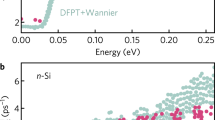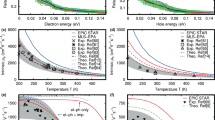Abstract
Whereas structure–property relationships have long guided the discovery and optimization of novel materials1,2,3, formal quantitative methods to identify such relationships in crystalline systems are beginning to emerge4,5,6,7,8. Among them is cluster expansion9,10,11,12,13, which has been successfully used to parametrize the configurational dependence of important scalar physical properties such as bandgaps14, Curie temperatures15, equation-of-state parameters16,17 and densities of states18,19,20. However, cluster expansion is currently unable to handle anisotropic properties, a key distinguishing feature of crystalline systems central to the design of modern epitaxial structures and devices. Here, I introduce a tensorial cluster expansion enabling the prediction of fundamental tensor-valued material properties such as elasticity, piezoelectricity, dielectric constants, optoelectric coupling, anisotropic diffusion coefficients, surface energy and stress. As an application, I develop predictive ab initio models of anisotropic properties relevant to the design and optimization of III–V semiconductor epitaxial optoelectronic devices21,22.
This is a preview of subscription content, access via your institution
Access options
Subscribe to this journal
Receive 12 print issues and online access
$259.00 per year
only $21.58 per issue
Buy this article
- Purchase on Springer Link
- Instant access to full article PDF
Prices may be subject to local taxes which are calculated during checkout


Similar content being viewed by others
References
Olson, G. Computational design of hierarchically structured materials. Science 277, 1237–1242 (1997).
Liu, Z. K., Chen, L. Q. & Rajan, K. Linking length scales via materials informatics. JOM 58, 42–50 (2006).
Ashby, M. F. Materials Selection in Mechanical Design 2nd edn (Butterworth-Heinemann, Oxford, 1999).
Morgan, D., Ceder, G. & Curtarolo, S. High-throughput and data mining with ab-initio methods. Meas. Sci. Technol. 16, 296–301 (2005).
Morgan, D. & Ceder, G. in Handbook of Materials Modeling Volume Part A (ed. Yip, S.) 395–422 (Springer, Dordrecht, 2005).
Suh, C. & Rajan, K. Virtual screening and QSAR formulations for crystal chemistry. QSAR Comb. Sci. 24, 114–119 (2005).
Johannesson, G. H. et al. Combined electronic structure and evolutionary search approach to materials design. Phys. Rev. Lett. 88, 255506 (2002).
Rajan, K. Materials informatics. Mater. Today 8, 38–45 (2005).
Sanchez, J. M., Ducastelle, F. & Gratias, D. Generalized cluster description of multicomponent systems. Physica A 128, 334–350 (1984).
de Fontaine, D. Cluster approach to order–disorder transformation in alloys. Solid State Phys. 47, 33–176 (1994).
Zunger, A. in NATO ASI on Statics and Dynamics of Alloy Phase Transformation Vol. 319 (eds Turchi, P. E. & Gonis, A.) 361–419 (Plenum, New York, 1994).
Asta, M., Ozolins, V. & Woodward, C. A first-principles approach to modeling alloy phase equilibria. J. Mineral. Met. Mater. Soc. 53, 16–19 (2001).
Ceder, G., van der Ven, A., Marianetti, C. & Morgan, D. First-principles alloy theory in oxides. Modelling Simul. Mater. Sci. Eng. 8, 311–321 (2000).
Franceschetti, A. & Zunger, A. The inverse band-structure problem of finding an atomic configuration with given electronic properties. Nature 402, 60–63 (1999).
Franceschetti, A. et al. First-principles combinatorial design of transition temperatures in multicomponent systems: The case of Mn in GaAs. Phys. Rev. Lett. 97, 047202 (2006).
Asta, M., McCormack, R. & de Fontaine, D. Theoretical study of alloy stability in the Cd–Mg system. Phys. Rev. B 48, 748–766 (1993).
Geng, H. Y., Sluiter, M. H. F. & Chen, N. X. Order-disorder effects on the equation of state for fcc Ni–Al alloys. Phys. Rev. B 72, 014204 (2005).
Garbulsky, G. D. & Ceder, G. Effect of lattice vibrations on the ordering tendencies in substitutional binary alloys. Phys. Rev. B 49, 6327–6330 (1994).
Geng, H. Y., Sluiter, M. H. F. & Chen, N. X. Cluster expansion of electronic excitations: Application to fcc Ni–Al alloys. J. Chem. Phys. 122, 214706 (2005).
van de Walle, A. & Ceder, G. The effect of lattice vibrations on substitutional alloy thermodynamics. Rev. Mod. Phys. 74, 11–45 (2002).
Pearton, S. J., Zolper, J. C., Shul, R. J. & Ren, F. GaN: Processing, defects, and devices. J. Appl. Phys. 86, 1–78 (1999).
Ambacher, O. Growth and applications of group III-nitrides. J. Phys. D 31, 2653–2710 (1998).
Nye, J. F. Physical Properties of Crystals: Their Representation by Tensors and Matrices (Oxford Univ. Press, USA, 1985).
Liu, J. Z., van de Walle, A., Ghosh, G. & Asta, M. Structure, energetics, and mechanical stability of Fe–Cu bcc alloys from first-principles calculations. Phys. Rev. B 72, 144109 (2005).
Laks, D. B., Ferreira, L. G., Froyen, S. & Zunger, A. Efficient cluster expansion for substitutional systems. Phys. Rev. B 46, 12587–12605 (1992).
van de Walle, A. & Ceder, G. Automating first-principles phase diagram calculations. J. Phase Equilib. 23, 348–359 (2002).
Lund, A. & Voorhees, P. W. The effects of elastic stress on coarsening in the Ni–Al system. Acta Mater. 50, 2085–2098 (2002).
Kresse, G. & Furthmüller, J. Efficient iterative schemes for ab initio total-energy calculations using a plane-wave basis set. Phys. Rev. B 54, 11169–11186 (1996).
Kresse, G. & Furthmüller, J. Efficiency of ab-initio total energy calculations for metals and semiconductors using a plane-wave basis set. Comput. Mater. Sci. 6, 15–50 (1996).
Kresse, G. & Joubert, D. From ultrasoft pseudopotentials to the projector augmented-wave method. Phys. Rev. B 59, 1758–1775 (1999).
Acknowledgements
This research was supported by the US National Science Foundation through TeraGrid resources provided by NCSA and SDSC under grant DMR060011N and through the Center for the Science and Engineering of Materials at Caltech.
Author information
Authors and Affiliations
Corresponding author
Supplementary information
Supplementary Information
Supplementary Discussion 1 & 2 (PDF 193 kb)
Rights and permissions
About this article
Cite this article
van de Walle, A. A complete representation of structure–property relationships in crystals. Nature Mater 7, 455–458 (2008). https://doi.org/10.1038/nmat2200
Received:
Accepted:
Published:
Issue Date:
DOI: https://doi.org/10.1038/nmat2200
This article is cited by
-
The synthesis, thermal behaviour, spectral and structural characterization, and in silico prediction of pharmacokinetic parameters of tetraalkylammonium salts of non-steroidal anti-inflammatory drug nimesulide
Scientific Reports (2023)
-
Finding stable multi-component materials by combining cluster expansion and crystal structure predictions
npj Computational Materials (2023)
-
Cluster Expansion of Alloy Theory: A Review of Historical Development and Modern Innovations
JOM (2021)
-
Calculation of Existence Domains and Optimized Phase Diagram for the Nb-Ti Binary Alloy System Using Computational Methods
Journal of Phase Equilibria and Diffusion (2020)
-
First principles calculations on the effect of interstitial oxygen on phase stability and β–α″ martensitic transformation in Ti–Nb alloys
Journal of Materials Science (2018)



